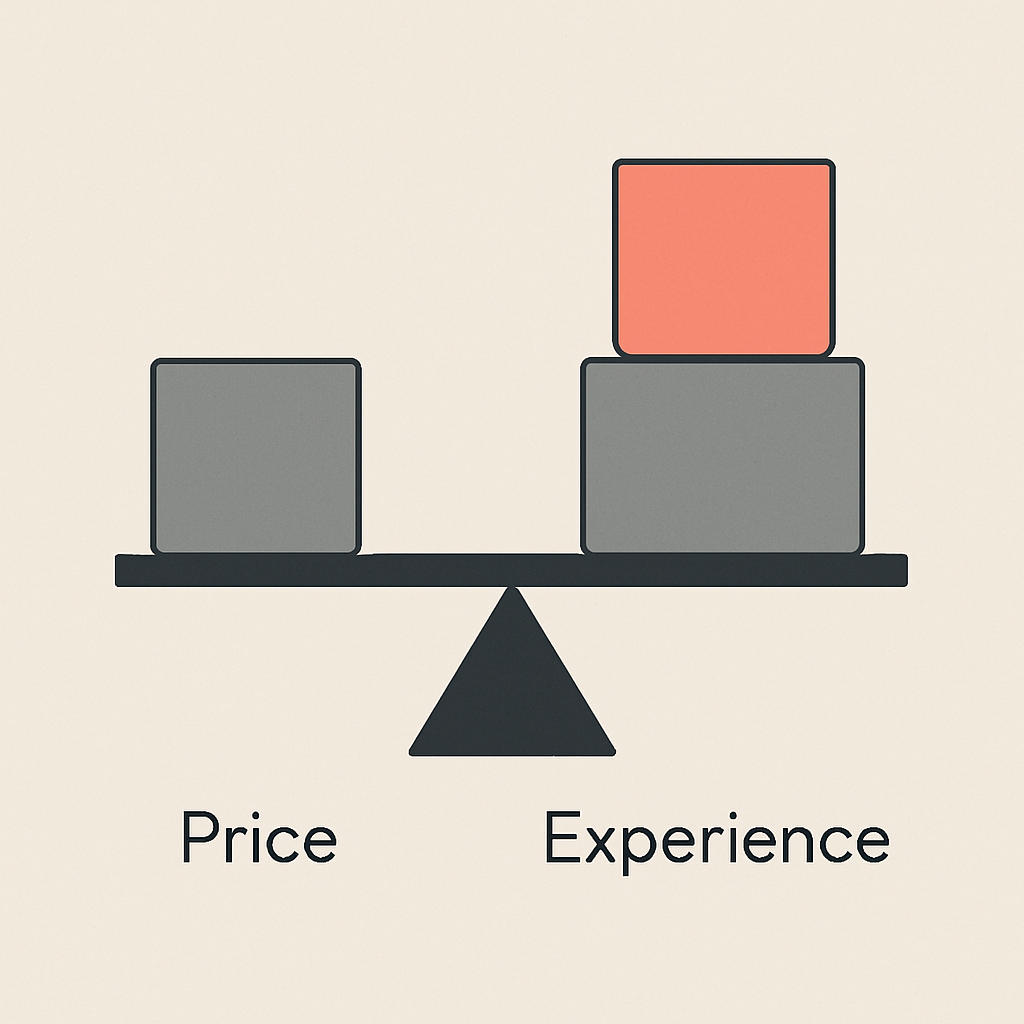Customer Experience Design: Building Connections That Convert
There's a moment that happens between browsing and buying that most businesses never see.
Your potential customer is three clicks deep into your website. They've read your homepage, maybe browsed a product page. They're interested, genuinely interested. But then something breaks. Maybe it's the checkout flow that asks for too much information. Maybe it's the support chat that feels robotic. Maybe it's just the subtle sense that this brand doesn't quite get them.
They close the tab. Not because your product isn't good, but because the experience felt like work instead of welcome.
That invisible moment of disconnection? That's where revenue walks away, quietly and without complaint.
In this journal, we will explore customer experience design and how you can implement it.
The Empathy Deficit Crisis
Most businesses are solving for efficiency when they should be solving for understanding. They've automated their way out of human connection, replacing conversations with chatbots, intuition with algorithms, and personal touch with "personalization" that feels anything but personal.
The result? Customers who complete purchases but never feel seen. They buy from you, but they don't buy into you.
While 72% of businesses rank CX as their top priority, they're still designing experiences that feel like they were created by people who've never been customers themselves.
The Architecture of Feeling Understood
In the article titled, "The Importance of Feeling Seen and How to Make People Feel Seen", emphasizes something that we've known in customer exprience design for long time: the difference between being understood and being processed.
Most businesses think they're personalizing experiences when they're actually just categorizing customers. They know your purchase history, your demographic profile, your behavioural patterns. But they don't know that you're shopping for your mother's birthday gift at 11 PM because you just remembered it's tomorrow, or that you're researching this product because your old one broke and you're frustrated that you have to replace it again.
The customer experience equivalent of "radical presence" isn't about more data or better algorithms. It's about designing interactions that respond to who someone is in the moment they're engaging with you, not who your system thinks they should be.
The Data Behind the Design
The numbers tell a compelling story. Companies that invest in CX improvements see remarkable returns: 84% report boosted revenue, 95% experience increased customer loyalty, and 79% achieve cost reductions. These aren't just statistics; they're proof that when you prioritize human experience, business success follows naturally.
When 64% of consumers consider customer experience more important than price, it becomes clear that competing on cost alone is no longer sufficient. The brands that thrive understand that price is what you pay, but experience is what you remember.

The Psychology of Seamless Interaction
Great customer experience design operates on multiple levels of human psychology. It anticipates needs before they're articulated. It removes barriers before they're encountered. It creates moments of delight that feel natural rather than manufactured.
Modern consumers expect speed, convenience, and consistency. What IBM research identifies as the core pillars of customer experience trends. Yet within these expectations lies an opportunity for brands to differentiate through thoughtful implementation rather than feature proliferation.
Designing for Emotional Resonance
Emotion drives every decision - that’s not opinion, it’s psychology. Whether they realize it or not, customers are constantly asking: Do I trust you? Do I feel seen? Am I comfortable here?
Your job as a brand is to answer with presence - not pressure. Every touchpoint, no matter how small, contributes to that emotional arc. Get the details right, and you build something lasting. Miss them, and the connection fades.
How to Improve Customer Experience Design
Building effective customer experience design requires a systematic approach that balances strategic thinking with creative intuition. The framework begins with deep customer research, not just surveys and analytics, but genuine observation and empathy for the human experience.
This research informs the creation of customer journey maps that capture both functional and emotional needs at each touchpoint. The best journey maps reveal opportunities for meaningful improvement rather than simply documenting current processes. They show you where the music skips, where the conversation lags, where the magic could happen.
From this foundation, teams can design interventions that feel natural and helpful rather than forced or promotional. The goal is to create experiences that customers barely notice, not because they're unremarkable, but because they work so seamlessly that friction disappears entirely.
Customer experience is rarely loud - it’s often quiet confidence.
That’s what we focused on with ARCHITECTS, a New York–based studio known for fusing classical principles with modern precision. The goal wasn’t just to “brand” them - it was to create a feeling of trust from the very first interaction.

Their audience? High-caliber clients who value control, clarity, and discretion.
So we built a brand that feels like the experience they deliver: intentional, clean, restrained. From the squared “A” symbol (a nod to precision and form) to the structured, grid-led layouts, every touchpoint was engineered to communicate confidence without overstatement. The result? A brand that doesn’t just represent the studio - it operates like the studio. It is their customer experience, distilled.
Customer Experience Design Best Practices
Effective Customer Experience Design isn't about grand gestures—it's about getting the fundamentals right consistently. The most successful brands focus on a few core practices that compound over time to create memorable experiences.
Start with genuine customer research. Go beyond surveys and analytics. Observe real customers in real situations. Understand not just what they do, but why they do it and how they feel while doing it. The best insights come from watching customers struggle with problems they didn't even know they had.
Map the complete emotional journey. Every interaction carries emotional weight. Document not just the functional steps customers take, but the feelings they experience at each touchpoint.
Where do they feel confident? Frustrated? Delighted? These emotional moments are where loyalty is won or lost.
Design for the 80/20 rule. Focus your energy on the 20% of touchpoints that create 80% of the impact. Usually, these are moments of high emotion - onboarding, problem resolution, or key decision points. Perfect these before optimizing everything else.
Remove friction before adding features. Most experience problems aren't solved by adding more - they're solved by taking away. Eliminate unnecessary steps, reduce cognitive load, and make the path to value as direct as possible.
Test with real humans, not personas. Personas are useful for alignment, but they can't replace actual customer feedback. Regular testing with real users reveals gaps between what you think customers want and what they actually need.
The brands that excel at customer experience design treat these practices as ongoing disciplines, not one-time projects.
The Competitive Advantage of Thoughtful Design
In crowded markets, customer experience design becomes a primary differentiator. When products and services reach functional parity, the experience becomes the deciding factor in customer choice and loyalty. It's the difference between being selected and being preferred, between being used and being loved.
This advantage compounds over time. Customers who have positive experiences become advocates, reducing acquisition costs and increasing lifetime value. They also provide valuable feedback that helps refine and improve the experience for future customers.
The organizations that thrive understand that customer experience design isn't a department or a project; it's a mindset that influences every decision, from product development to internal processes to external communications.
Customer Experience Design vs User Experience Design
While often confused or used interchangeably, Customer Experience Design and User Experience Design serve distinctly different purposes in creating successful businesses. Understanding the difference is crucial for organizations looking to build comprehensive customer relationships.
User Experience Design focuses primarily on digital interactions—websites, apps, and software interfaces. UX designers optimize usability, information architecture, and interface design to help users complete specific tasks efficiently. The scope is typically limited to digital touchpoints and immediate user goals.
Customer Experience Design takes a holistic view of the entire customer relationship. It encompasses every interaction a customer has with a brand—from initial awareness through purchase, support, and long-term loyalty. CX Design considers emotional journeys, cross-channel consistency, and business outcomes beyond individual task completion.
The key distinction lies in scope and timeline. UX Design asks "How can we make this interface easier to use?" while Customer Experience Design asks "How can we build a relationship that creates lasting value for both the customer and the business?"
Both disciplines are essential and work best when aligned. Great UX Design contributes to excellent Customer Experience, but focusing solely on digital usability without considering the broader customer relationship leaves significant value on the table.
Looking Forward: The Evolution Continues
Customer experience design continues to evolve as technology advances and customer expectations shift. The brands that succeed will be those that maintain focus on human needs while leveraging new capabilities to serve those needs more effectively.
The future belongs to organizations that can create experiences that feel both innovative and timeless, sophisticated enough to impress, simple enough to understand, and valuable enough to remember. In this landscape, the principles of thoughtful design, authentic connection, and strategic implementation will remain constant even as the tools and tactics continue to evolve.
Less noise, more meaning. Always.
Ready to transform your customer experience design? Let's explore how strategic thinking and creative implementation can build the connections that convert.
Frequently Asked Questions
What's the difference between Customer Experience Design and Customer Service? Customer Service is reactive - it responds to problems after they occur. Customer Experience Design is proactive - it anticipates needs and designs systems to prevent problems from happening in the first place. While customer service is one touchpoint, CX Design encompasses the entire customer relationship.
How long does it take to see results from Customer Experience Design improvements? Initial improvements in customer satisfaction can be seen within weeks, but business impact can emerge over 3-6 months.
Do I need a dedicated CX team to implement Customer Experience Design? Not necessarily. While larger organizations benefit from dedicated CX teams, smaller businesses can start by integrating CX thinking into existing roles. The key is having someone accountable for the end-to-end customer journey, whether that's a marketing manager, product owner, or business leader.
How is Customer Experience Design different from marketing? Marketing focuses on attracting customers and communicating value. Customer Experience Design focuses on delivering that value consistently across every interaction. Marketing makes promises; CX Design ensures those promises are kept throughout the customer relationship.
What tools do I need to start with Customer Experience Design? Start simple: customer feedback surveys, basic analytics, and journey mapping exercises using tools you already have. As you mature, consider specialized CX platforms, but the most important "tool" is a commitment to understanding your customers' actual experiences, not just their stated preferences.
Can small businesses compete with large companies on Customer Experience Design? Absolutely. Small businesses often have advantages in CX Design - they can move faster, make decisions quickly, and create more personal connections. Many customers prefer the authentic, human touch that smaller businesses can provide over the automated efficiency of larger corporations.














